DataGridView的用法
datagridview技巧
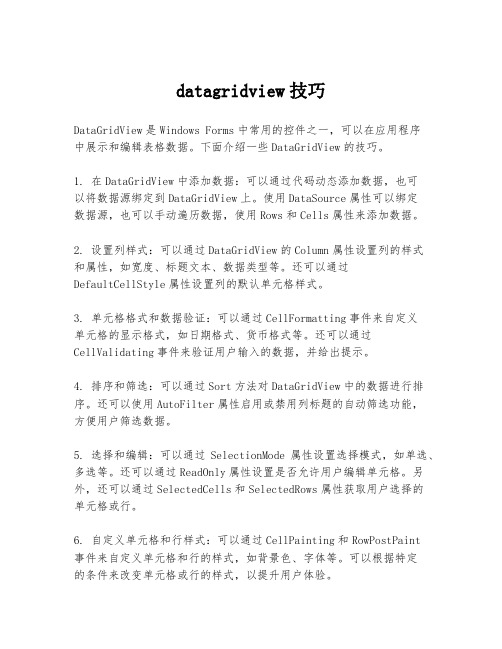
datagridview技巧DataGridView是Windows Forms中常用的控件之一,可以在应用程序中展示和编辑表格数据。
下面介绍一些DataGridView的技巧。
1. 在DataGridView中添加数据:可以通过代码动态添加数据,也可以将数据源绑定到DataGridView上。
使用DataSource属性可以绑定数据源,也可以手动遍历数据,使用Rows和Cells属性来添加数据。
2. 设置列样式:可以通过DataGridView的Column属性设置列的样式和属性,如宽度、标题文本、数据类型等。
还可以通过DefaultCellStyle属性设置列的默认单元格样式。
3. 单元格格式和数据验证:可以通过CellFormatting事件来自定义单元格的显示格式,如日期格式、货币格式等。
还可以通过CellValidating事件来验证用户输入的数据,并给出提示。
4. 排序和筛选:可以通过Sort方法对DataGridView中的数据进行排序。
还可以使用AutoFilter属性启用或禁用列标题的自动筛选功能,方便用户筛选数据。
5. 选择和编辑:可以通过SelectionMode属性设置选择模式,如单选、多选等。
还可以通过ReadOnly属性设置是否允许用户编辑单元格。
另外,还可以通过SelectedCells和SelectedRows属性获取用户选择的单元格或行。
6. 自定义单元格和行样式:可以通过CellPainting和RowPostPaint事件来自定义单元格和行的样式,如背景色、字体等。
可以根据特定的条件来改变单元格或行的样式,以提升用户体验。
7. 导出数据:可以通过DataGridView的GetClipboardContent方法将DataGridView中的数据导出为文本或HTML格式,方便数据的导出和共享。
以上是一些常用的DataGridView技巧,希望对您有帮助。
datagridview用法

DataGridView用法1.概述D a ta Gr id Vi ew是Wi n do ws Fo rm s中一种常用的控件,用于展示和编辑表格数据。
本文将介绍Da ta Gr id Vi ew的基本用法和常用功能。
2.基本用法2.1创建D a t a G r i d V i e w要使用D at aG ri dVi e w,首先需要在窗体上进行控件的创建和初始化。
可以通过拖拽控件到窗体上或者在代码中动态创建控件。
2.2数据绑定在D at aG ri dV ie w中展示数据通常需要进行数据绑定。
可以通过设置D a ta So ur ce属性来实现数据绑定,可以绑定Da ta Ta bl e、B i nd in gS ou rc e等数据源。
2.3列定义可以通过列定义来指定D at aG ri dV ie w中的列数、列名、列类型等属性。
可以使用Da ta Gr i dV ie w的Co lu mns集合来对列进行操作。
2.4行操作可以通过Da ta Gr idV i ew的R ow s集合对行进行操作,如添加、删除、插入等操作。
可以根据行索引或行对象进行操作。
3.常用功能3.1样式设置可以通过设置Da ta Gr i dV ie w的Ce ll Sty l e、C o lu mn He ad er De fau l tC el lS ty le、R ow H ea de rs De fa ul tCe l lS ty le等属性来设置样式,如背景色、字体、对齐方式等。
3.2单元格编辑D a ta Gr id Vi ew可以方便地对单元格进行编辑,可以根据需要设置单元格的可编辑性,只读属性等。
可以通过事件处理程序来实现特定单元格的编辑操作。
3.3排序和筛选D a ta Gr id Vi ew提供了对数据进行排序和筛选的功能。
可以通过设置A l lo wS or ti ng属性来启用排序功能,通过设置A l lo wU se rT oF il ter C ol um ns属性来启用筛选功能。
DataGridView控件用法合集11
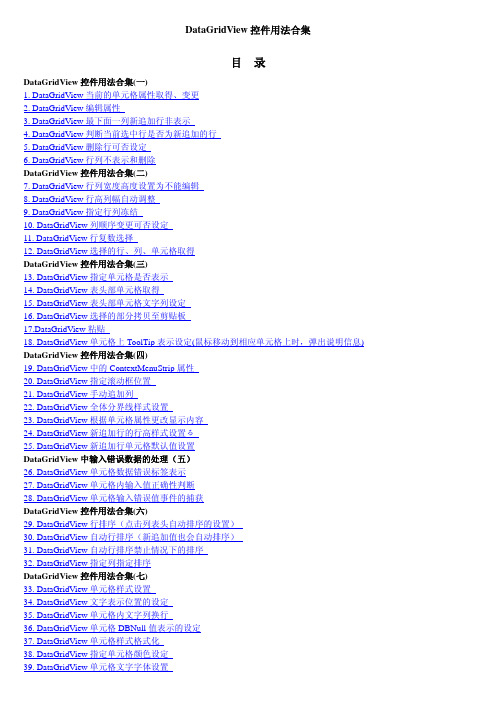
DataGridView控件用法合集目录DataGridView控件用法合集(一)1. DataGridView当前的单元格属性取得、变更2. DataGridView编辑属性3. DataGridView最下面一列新追加行非表示4. DataGridView判断当前选中行是否为新追加的行5. DataGridView删除行可否设定6. DataGridView行列不表示和删除DataGridView控件用法合集(二)7. DataGridView行列宽度高度设置为不能编辑8. DataGridView行高列幅自动调整9. DataGridView指定行列冻结10. DataGridView列顺序变更可否设定11. DataGridView行复数选择12. DataGridView选择的行、列、单元格取得DataGridView控件用法合集(三)13. DataGridView指定单元格是否表示14. DataGridView表头部单元格取得15. DataGridView表头部单元格文字列设定16. DataGridView选择的部分拷贝至剪贴板17.DataGridView粘贴18. DataGridView单元格上ToolTip表示设定(鼠标移动到相应单元格上时,弹出说明信息) DataGridView控件用法合集(四)19. DataGridView中的ContextMenuStrip属性20. DataGridView指定滚动框位置21. DataGridView手动追加列22. DataGridView全体分界线样式设置23. DataGridView根据单元格属性更改显示内容24. DataGridView新追加行的行高样式设置る25. DataGridView新追加行单元格默认值设置DataGridView中输入错误数据的处理(五)26. DataGridView单元格数据错误标签表示27. DataGridView单元格内输入值正确性判断28. DataGridView单元格输入错误值事件的捕获DataGridView控件用法合集(六)29. DataGridView行排序(点击列表头自动排序的设置)30. DataGridView自动行排序(新追加值也会自动排序)31. DataGridView自动行排序禁止情况下的排序32. DataGridView指定列指定排序DataGridView控件用法合集(七)33. DataGridView单元格样式设置34. DataGridView文字表示位置的设定35. DataGridView单元格内文字列换行36. DataGridView单元格DBNull值表示的设定37. DataGridView单元格样式格式化38. DataGridView指定单元格颜色设定39. DataGridView单元格文字字体设置40. DataGridView根据单元格值设定单元格样式DataGridView控件用法合集(八)41. DataGridView设置单元格背景颜色42. DataGridView行样式描画43. DataGridView显示行号44. DataGridView焦点所在单元格焦点框不显示的设定DataGridView控件用法合集(九)45. DataGridView中显示选择框CheckBox46. DataGridView中显示下拉框ComboBox47. DataGridView单击打开下拉框48. DataGridView中显示按钮49. DataGridView中显示链接50. DataGridView中显示图像DataGridView控件用法合集(十)51. DataGridView编辑中单元格控件取得52. DataGridView输入自动完成53. DataGridView单元格编辑时键盘KEY事件取得54. DataGridView下拉框(ComboBox)单元格编辑时事件取得55. DataGridView下拉框(ComboBox)单元格允许文字输入设定DataGridView控件用法合集(十一)56. DataGridView根据值不同在另一列中显示相应图片57. DataGridView中显示进度条(ProgressBar)58. DataGridView中添加MaskedTextBoxDataGridView控件用法合集(十二)59. DataGridView中Enter键按下焦点移至旁边的单元格60. DataGridView行集合化(Group)正文DataGridView控件用法合集(一)1. DataGridView当前的单元格属性取得、变更2. DataGridView编辑属性3. DataGridView最下面一列新追加行非表示4. DataGridView判断当前选中行是否为新追加的行5. DataGridView删除行可否设定6. DataGridView行列不表示和删除1.当前的单元格属性取得、变更[]'当前选中单元的值Console.WriteLine(DataGridView1.CurrentCell.Value)'当前列的Index值Console.WriteLine(DataGridView1.CurrentCell.ColumnIndex)'当前单元的行Index值Console.WriteLine(DataGridView1.CurrentCell.RowIndex)'将控件中(0, 0)处的值,赋给当前单元格.DataGridView1.CurrentCell = DataGridView1(0, 0)2.DataGridView编辑属性全部单元格编辑属性[]'DataGridView1只读属性DataGridView1.ReadOnly = True指定行列单元格编辑属性[]DataGridView1.Columns(1).ReadOnly = TrueDataGridView1.Rows(2).ReadOnly = TrueDataGridView1(0, 0).ReadOnly = True根据条件判断单元格的编辑属性下例中column2的值是True的时候,Column1设为可编辑[]Private Sub DataGridView1_CellBeginEdit(ByVal sender As Object, _ByVal e As DataGridViewCellCancelEventArgs) _Handles DataGridView1.CellBeginEditDim dgv As DataGridView = CType(sender, DataGridView)If dgv.Columns(e.ColumnIndex).Name = "Column1" AndAlso _Not CBool(dgv("Column2", e.RowIndex).Value) Thene.Cancel = TrueEnd IfEnd Sub3.DataGridView最下面一列新追加行非表示[]DataGridView1.AllowUserToAddRows = False4.判断当前选中行是否为新追加的行[]If DataGridView1.CurrentRow.IsNewRow ThenConsole.WriteLine("現在のセルがある行は、新しい行です。
DATAGRIDVIEW属性及方法

DATAGRIDVIEW属性及方法属性:1. AllowUserToAddRows:获取或设置一个值,指示是否允许用户添加新行。
2. AllowUserToDeleteRows:获取或设置一个值,指示是否允许用户删除行。
3. AllowUserToResizeColumns:获取或设置一个值,指示是否允许用户调整列的大小。
4. AllowUserToResizeRows:获取或设置一个值,指示是否允许用户调整行的大小。
5. AutoSizeColumnsMode:获取或设置值,指示列宽度的调整模式。
6. DataSource:获取或设置与该DataGridView关联的数据源。
7. RowHeadersVisible:获取或设置一个值,指示是否显示行标题。
8. ColumnHeadersVisible:获取或设置一个值,指示是否显示列标题。
9. ReadOnly:获取或设置一个值,指示是否只读。
10. MultiSelect:获取或设置一个值,指示是否可以同时选择多个单元格。
方法:1. ClearSelection(:取消选择所有选定的单元格。
2. Refresh(:重新绘制DataGridView控件。
3. Sort(DataGridViewColumn, ListSortDirection):按指定的列和排序顺序对表格进行排序。
4. SelectAll(:选择所有单元格。
5. Clear(:清除掉DataGridView控件中的所有数据。
7. ClearSelection(:清除当前选定的单元格的选择。
除了上述属性和方法外,DataGridView还有一些事件,可以让我们在特定的情况下作出响应。
例如,CellClick事件在单击单元格时触发,可以用来获取当前选中的单元格的值。
另外,DataGridView还有许多其他的属性和方法,用于设置和操作表格的样式、行高、列宽等。
总结起来,DataGridView是Windows Forms中非常常用的表格控件,具有丰富的属性和方法,用于设置和操作表格的外观和行为。
DataGridView的使用总结

DataGridView的使⽤总结⼀、属性应⽤1.设置单元格⿏标点击后就进⼊编辑状态设置DataGridView控件的EditMode这个属性,即EditMode = System.Windows.Forms.DataGridViewEditMode.EditOnEnter这样当⿏标点击单元格时就会变成编辑状态。
2.设置DataGridView控件的⾏选择样式设置DataGridView控件的SelectionMode这个属性,即SelectionMode = System.Windows.Forms.DataGridViewSelectionMode.FullRowSelect这样我们再选中的时候就是以⾏的形式选中的。
3.当⽤户点击列标题时不进⾏排序在默认情况下,当⽤户点击DataGridView控件的列标题时会⾃动对内容进⾏排序,现在我们禁⽌它进⾏排序,通过设置每⼀列的SortMode这个属性来实现,即SortMode=NotSortable这样当我们点击列标题时就不会⾃动进⾏排序了。
4.去除DataGridView⾃带的⼀⾏(带有*号的那⼀⾏,或者是不允许⽤户添加数据)DataGridView控件在默认的情况下会⾃动的绑上⼀⾏空数据,这⼀⾏空数据可以使⽤户进⾏数据添加,现在我们想去除这⼀列,通过设置属性AllowUserToAddRows=false;这样在绑定的时候就不会再显⽰这⼀⾏了。
5.设置单元格不可编辑⽅法⼀:我们可以在控件完成数据绑定后在对DataGridView控件进⾏遍历,根据条件设置单元格的readonly 属性,使此单元格不能进⾏编辑。
如下:/// <summary>/// 更新数据/// </summary>public void UpdateData(){//获取数据源dgvliucycx.DataSource =bll_liucy.GetAllList().Tables[0].DefaultView;//改变废弃项的背景颜⾊ChangeColor();//设置修改时间和修改⼈列为只读的BandColumn();/// 改变DataGridView控件废弃项的背景颜⾊/// </summary>public void ChangeColor(){//将已废弃的样品记录背景⾊表⽰为蓝⾊try{for (int i = 0; i < dgvliucycx.Rows.Count; i++){if(Convert.ToString(dgvliucycx.Rows[i].Cells["BIAOS"].Value) == "废弃"){dgvliucycx.Rows[i].DefaultCellStyle.BackColor = Color.Aqua;}}}catch (Exception ex){KryptonMessageBox.Show(ex.ToString());}}/// <summary>绑定修改⼈和修改时间这⼀列,进攻参考设定修改⼈和修改⽇期、标识为只读的⽅法⼆:我们还可以在CellBeginEdit事件中进⾏判断是否对单元格进⾏编辑,如下:// CellBeginEdit 事件处理⽅法private void DataGridView1_CellBeginEdit(objectsender,DataGridViewCellCancelEventArgs e){DataGridView dgv = (DataGridView)sender;//是否可以进⾏编辑的条件检查if (dgv.Columns[e.ColumnIndex].Name =="Column1" &&!(bool)dgv["Column2", e.RowIndex].Value){// 取消编辑e.Cancel = true;}}6.DataGridView判断新增⾏DataGridView的AllowUserToAddRows属性为True时也就是允许⽤户追加新⾏的场合下, DataGridView的最后⼀⾏就是新追加的⾏(*⾏)。
dataGridView的用法

dataGridView的用法dataGridView的几个基本操作:1、获得某个(指定的)单元格的值:dataGridView1.Row[i].Cells[j].Value;2、获得选中的总行数:dataGridView1.SelectedRows.Count;3、获得当前选中行的索引:dataGridView1.CurrentRow.Index;4、获得当前选中单元格的值:dataGridView1.CurrentCell.Value;5、取选中行的数据string[] str = new string[dataGridView.Rows.Count];for(int i;i<datagridview1.rows.count;i++)< bdsfid="75" p=""></datagridview1.rows.count;i++)<>{if(dataGridView1.Rows[i].Selected == true){str[i] = dataGridView1.Rows[i].Cells[1].Value.ToString();}}7、获取选中行的某个数据int a = dataGridView1.SelectedRows.Index;dataGridView1.Rows[a].Cells["你想要的某一列的索引,想要几就写几"].Value;int a=dataGridView1.CurrentRow.Index;stringstr=dataGridView1.Row[a].Cells["strName"].Value.T ostring();DataRowState rowState=new DataRowState ();DataTable dt=(DataTable)this.dgvStudentInfo .DataSource ;for (int i = 0; i < dt.Rows.Count; i++){//rowState == DataRowState.Added || rowState == DataRowState.Detached ||if (rowState == DataRowState.Modified){//dt.Rows[i].Delete();//dt.ImportRow(dt.Rows[i]);//dgvStudentInfo.DataSource = dt;//dgvStudentInfo.Refresh();bllStudent.Update(stuModel);}}选中行的某个数据//string stuid = dgvStuInfo.Rows[0].Cells[0].Value.T oString();//int id = this.dgvStuInfo.CurrentRow.Cells[0].RowIndex;//string stuid = this.dgvStuInfo.Rows[id].Cells[0].Value.ToString();。
DataGridView控件用法(一)绑定数据

DataGridView控件⽤法(⼀)绑定数据⼀、DataGridView控件的⽤法(如何绑定、修改其中某⼀列值、添加序号列、交换任意2列显⽰顺序)1. DataGridView绑定数据源。
在页⾯上拖放⼀个DataGridView控件//连接数据库读取数据,为DataGridView赋值。
String strConn = "server= .\XWPC_DATABASE;uid=数据库⽤户名;pwd=数据库密码;database=数据库名";SqlConnection conn = new SqlConnection(strConn);String sqlId = "select * from [USER] ";conn.Open();SqlCommand cmd = new SqlCommand(sqlId, conn);SqlDataAdapter da = new SqlDataAdapter(cmd);DataSet ds = new DataSet();da.Fill(ds, "USER");DataGridView.DataSource = ds;DataGridView.DataMember = "USER";conn.Close();上述代码执⾏后页⾯上数据显⽰是这样的:2. 修改 DataGridView中数据的表头(本来默认是数据库中的字段名)。
//改变DataGridView的表头DataGridView.Columns[1].HeaderText = "⽤户名";//设置该列宽度DataGridView.Columns[1].Width = 70;3. 将DataGridView最前⾯⼀列编号改为从1开始依次增加的序号(默认的字段编号对⽤户没意义,⽽且不连续)。
//在表前⾯加⼀列表⽰序号DataGridView.Columns[0].HeaderText = "编号";DataGridView.Columns[0].Width = 60;//⾃动整理序列号int coun = DataGridView.RowCount;for (int i = 0; i < coun - 1; i++){DataGridView.Rows[i].Cells[0].Value = i + 1;DataGridView.Rows[i].Cells["USER_ID"].Value = i + 1;}//改变DataGridView的表头DataGridView.Columns[1].HeaderText = "⽤户名";//设置该列宽度DataGridView.Columns[1].Width = 70;DataGridView.Columns[2].HeaderText = "密码";DataGridView.Columns[2].Width = 70;//默认按顺序每列DataGridView依次从ds中对应赋值DataGridView.Columns[0].DataPropertyName = ds.Tables[0].Columns[0].ToString();执⾏后效果如下:4. 对调 DataGridView中某两列的顺序,代码如下: //改变DataGridView的表头DataGridView.Columns[1].HeaderText = "密码";//设置该列宽度DataGridView.Columns[1].Width = 70;DataGridView.Columns[1].DataPropertyName =ds.Tables[0].Columns[2].ToString();DataGridView.Columns[2].HeaderText = "⽤户名";DataGridView.Columns[2].Width =70;DataGridView.Columns[2].DataPropertyName = ds.Tables[0].Columns[1].ToString(); 执⾏效果:5. 设置DataGridView使某列不显⽰、使其不可直接编辑、使其不显⽰最后⼀⾏空⽩。
datagridview控件用法
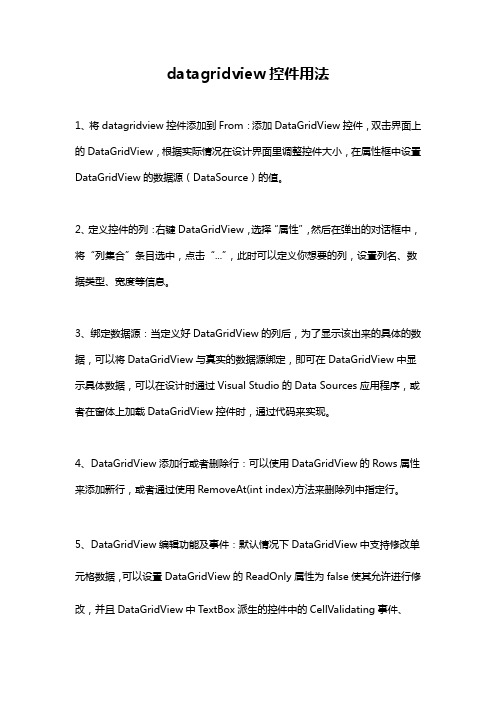
datagridview控件用法
1、将datagridview控件添加到From:添加DataGridView控件,双击界面上的DataGridView,根据实际情况在设计界面里调整控件大小,在属性框中设置DataGridView的数据源(DataSource)的值。
2、定义控件的列:右键DataGridView,选择“属性”,然后在弹出的对话框中,将“列集合”条目选中,点击“...”,此时可以定义你想要的列,设置列名、数据类型、宽度等信息。
3、绑定数据源:当定义好DataGridView的列后,为了显示该出来的具体的数据,可以将DataGridView与真实的数据源绑定,即可在DataGridView中显示具体数据,可以在设计时通过Visual Studio的Data Sources应用程序,或者在窗体上加载DataGridView控件时,通过代码来实现。
4、DataGridView添加行或者删除行:可以使用DataGridView的Rows属性来添加新行,或者通过使用RemoveAt(int index)方法来删除列中指定行。
5、DataGridView编辑功能及事件:默认情况下DataGridView中支持修改单元格数据,可以设置DataGridView的ReadOnly属性为false使其允许进行修改,并且DataGridView中TextBox派生的控件中的CellValidating事件、
CellValueChanged事件等都可以响应DataGridView的编辑功能,可以在这些事件中实现对数据的监测或者保存数据的操作。
DataGridView 行、列的隐藏和删除
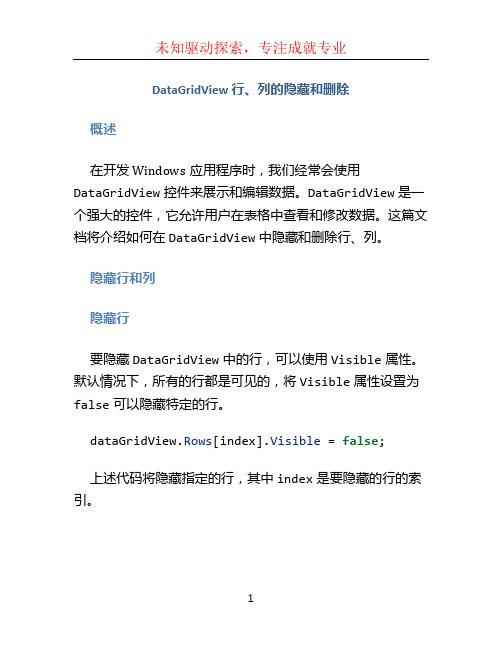
DataGridView 行、列的隐藏和删除概述在开发Windows应用程序时,我们经常会使用DataGridView控件来展示和编辑数据。
DataGridView是一个强大的控件,它允许用户在表格中查看和修改数据。
这篇文档将介绍如何在DataGridView中隐藏和删除行、列。
隐藏行和列隐藏行要隐藏DataGridView中的行,可以使用Visible属性。
默认情况下,所有的行都是可见的,将Visible属性设置为false可以隐藏特定的行。
dataGridView.Rows[index].Visible = false;上述代码将隐藏指定的行,其中index是要隐藏的行的索引。
要隐藏DataGridView中的列,可以使用Visible属性。
默认情况下,所有的列都是可见的,将Visible属性设置为false可以隐藏特定的列。
dataGridView.Columns[index].Visible = false;上述代码将隐藏指定的列,其中index是要隐藏的列的索引。
删除行和列删除行要删除DataGridView中的行,可以使用RemoveAt方法。
该方法将从DataGridView的行集合中删除指定索引的行。
dataGridView.Rows.RemoveAt(index);上述代码将删除指定索引的行,其中index是要删除的行的索引。
要删除DataGridView中的列,可以使用RemoveAt方法。
该方法将从DataGridView的列集合中删除指定索引的列。
dataGridView.Columns.RemoveAt(index);上述代码将删除指定索引的列,其中index是要删除的列的索引。
示例下面的示例演示了如何在DataGridView中隐藏和删除行、列。
// 隐藏行dataGridView.Rows[0].Visible = false;// 隐藏列dataGridView.Columns[1].Visible = false;// 删除行dataGridView.Rows.RemoveAt(2);// 删除列dataGridView.Columns.RemoveAt(3);上述代码将隐藏第一行、第二列,并删除第三行和第四列。
datagridview 用法
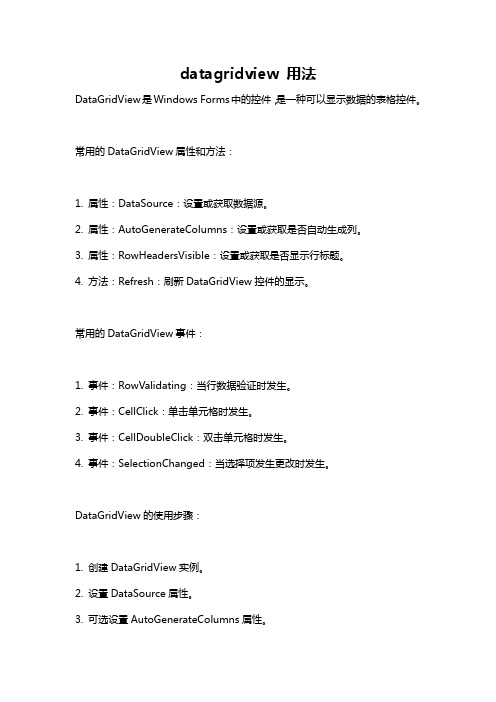
datagridview 用法DataGridView是Windows Forms中的控件,是一种可以显示数据的表格控件。
常用的DataGridView属性和方法:1. 属性:DataSource:设置或获取数据源。
2. 属性:AutoGenerateColumns:设置或获取是否自动生成列。
3. 属性:RowHeadersVisible:设置或获取是否显示行标题。
4. 方法:Refresh:刷新DataGridView控件的显示。
常用的DataGridView事件:1. 事件:RowValidating:当行数据验证时发生。
2. 事件:CellClick:单击单元格时发生。
3. 事件:CellDoubleClick:双击单元格时发生。
4. 事件:SelectionChanged:当选择项发生更改时发生。
DataGridView的使用步骤:1. 创建DataGridView实例。
2. 设置DataSource属性。
3. 可选设置AutoGenerateColumns属性。
4. 可选设置RowHeadersVisible属性及其他属性。
5. 注册事件处理程序。
6. 添加DataGridView到窗体中。
下面是一个简单示例代码:C#代码:csharpdataGridView1.DataSource = dataTable; dataTable为绑定数据源dataGridView1.AutoGenerateColumns = true;dataGridView1.RowHeadersVisible = false;dataGridView1.CellClick += DataGridView_CellClick;注:DataGridView_CellClick是事件处理程序的方法名,需要自行定义。
datagridview_各种用法
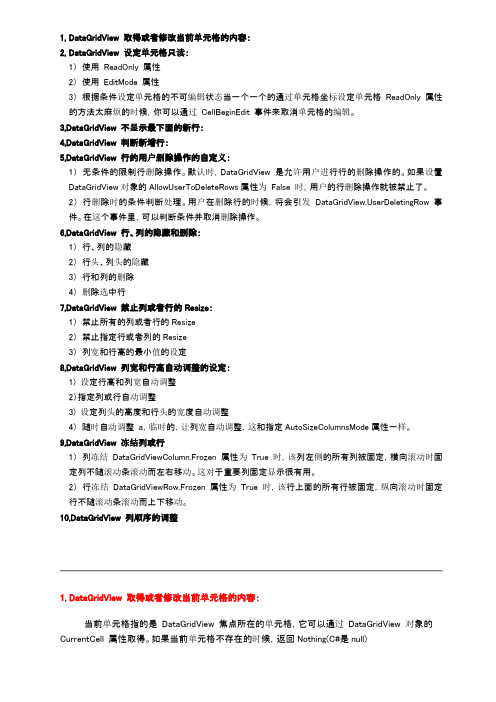
1, DataGridView 取得或者修改当前单元格的内容:2, DataGridView 设定单元格只读:1)使用ReadOnly 属性2)使用EditMode 属性3)根据条件设定单元格的不可编辑状态当一个一个的通过单元格坐标设定单元格ReadOnly 属性的方法太麻烦的时候,你可以通过CellBeginEdit 事件来取消单元格的编辑。
3,DataGridView 不显示最下面的新行:4,DataGridView 判断新增行:5,DataGridView 行的用户删除操作的自定义:1)无条件的限制行删除操作。
默认时,DataGridView 是允许用户进行行的删除操作的。
如果设置DataGridView对象的AllowUserToDeleteRows属性为False 时,用户的行删除操作就被禁止了。
2)行删除时的条件判断处理。
用户在删除行的时候,将会引发erDeletingRow 事件。
在这个事件里,可以判断条件并取消删除操作。
6,DataGridView 行、列的隐藏和删除:1)行、列的隐藏2)行头、列头的隐藏3)行和列的删除4)删除选中行7,DataGridView 禁止列或者行的Resize:1)禁止所有的列或者行的Resize2)禁止指定行或者列的Resize3)列宽和行高的最小值的设定8,DataGridView 列宽和行高自动调整的设定:1) 设定行高和列宽自动调整2)指定列或行自动调整3) 设定列头的高度和行头的宽度自动调整4)随时自动调整a,临时的,让列宽自动调整,这和指定AutoSizeColumnsMode属性一样。
9,DataGridView 冻结列或行1)列冻结DataGridViewColumn.Frozen 属性为True 时,该列左侧的所有列被固定,横向滚动时固定列不随滚动条滚动而左右移动。
这对于重要列固定显示很有用。
2)行冻结DataGridViewRow.Frozen 属性为True 时,该行上面的所有行被固定,纵向滚动时固定行不随滚动条滚动而上下移动。
sunnyui datagridview详细用法

sunnyui datagridview详细用法DataGridView是Windows Forms中的一个常用的控件,用于显示和编辑数据。
它提供了直观、易于使用的界面,用于显示和编辑表格数据。
在SunnyUI框架中,DataGridView控件提供了许多方便的功能和选项,使得数据展示更加方便。
本文将详细介绍SunnyUI框架中的DataGridView控件的用法。
一、DataGridView控件简介DataGridView控件提供了一种方便的方式来显示和编辑数据,它允许用户通过简单的鼠标操作进行选择和编辑数据。
DataGridView控件还提供了许多功能,如行高、列宽的自动调整、分页、排序、筛选等。
这些功能使得DataGridView控件在各种应用程序中都非常有用。
二、DataGridView控件属性设置在使用DataGridView控件之前,我们需要设置一些属性来控制其外观和行为。
以下是一些常用的属性及其说明:1. AutoGenerateColumns:决定是否自动生成列头和列索引。
默认为True,即自动生成列头和列索引。
2. AllowUserToAddRows:是否允许用户添加行。
默认为True。
3. AllowUserToDeleteRows:是否允许用户删除行。
默认为True。
4. RowHeights:行的高度设置。
可以通过设置此属性来改变行的高度。
5. ColumnCount和Columns:设置列的数量和名称。
可以设置多个列的名称和属性。
三、DataGridView控件数据绑定将DataGridView控件绑定到数据源是使用DataGridView控件的关键步骤之一。
可以使用以下方法将数据绑定到DataGridView控件:1. 使用DataSource属性将数据绑定到DataGridView控件。
可以将DataSet、DataTable或自定义对象集合绑定到DataGridView控件。
DataGridView控件用法(可能不是很全面,因为这是自己常常用到的一些小总结):

DataGridView控件⽤法(可能不是很全⾯,因为这是⾃⼰常常⽤到的⼀些⼩总结):⼀、DataGridView属性设置1、我们单击选中⾏的时候,默认是选择⼀个单元格,不能选择⼀整⾏,我们只需设置DataGridView的属性SelectionMode为FullRowSelect 。
⽤代码表⽰:this.dataGridView1.SelectionMode =DataGridViewSelectionMode.FullRowSelect;2、选择多⾏,可设置DataGridView的属性MultiSelect为false 。
⽤代码表⽰:this.dataGridView1.MultiSelect = false;这样就使DataGridView不能够选择多⾏,只能选择⼀⾏了3、是否⾃动创列:dataGridView1.AutoGenerateColumns = false;4、DataGridView这个控件会默认的在第⼀⾏第⼀列选中。
这个问题我在⽹上看到了很多回答,也有很多⼈问。
可能是我⽤的⽅法不对,效果不是很好后来找到了这种答案: dataGridView1.ClearSelection();⼀⾏就可以。
5、设置标题样式&字体:⾸先把这个“EnableHeadersVisualStyles”属性设置为false。
在然后设置标题的样式,设置这个属性“ColumnHeadersDefaultCellStyle”:6、设置⾏的样式,设置DefaultCellStyle属性:1、单击项或双击⾏时,获取⾏的数据(CellClick)1private void DGV_CellClick(object sender, DataGridViewCellEventArgs e)2 {34if (e.RowIndex != -1)//判断是否点在⾏上5 {6 txt_No.Text = this.DGV["Col_No", e.RowIndex].Value.ToString();7 txt_Name.Text = this.DGV["Col_Name", e.RowIndex].Value.ToString();8 txt_Type.Text = this.DGV["Col_Type", e.RowIndex].Value.ToString();9 txt_Time.Text = this.DGV["Col_Time", e.RowIndex].Value.ToString();10 }11 }View Code“Col_No”。
datagridview控件用法

datagridview控件用法DataGridView控件是Windows Forms中最常用的控件之一,它可以用于显示和编辑数据。
在本文中,我们将介绍DataGridView控件的用法,包括如何绑定数据、设置列、样式和事件处理等。
1. 绑定数据DataGridView控件可以绑定各种数据源,包括DataTable、DataSet、BindingSource等。
绑定数据的方法有两种:一种是在设计时通过属性窗口设置,另一种是在运行时通过代码设置。
在设计时,我们可以通过以下步骤绑定数据:1)将DataGridView控件拖放到窗体上;2)在属性窗口中选择DataSource属性,然后选择要绑定的数据源;3)选择DataMember属性,然后选择要显示的数据表或数据集。
在运行时,我们可以通过以下代码绑定数据:dataGridView1.DataSource = dataTable;其中,dataTable是一个DataTable对象,它包含要显示的数据。
2. 设置列DataGridView控件可以显示多列数据,我们可以通过以下方法设置列:1)在设计时,通过列编辑器添加列;2)在运行时,通过代码添加列。
在设计时,我们可以通过以下步骤添加列:1)在属性窗口中选择Columns属性,然后点击“…”按钮;2)在列编辑器中添加列,设置列的属性,如HeaderText、DataPropertyName、Width等。
在运行时,我们可以通过以下代码添加列:DataGridViewTextBoxColumn column = new DataGridViewTextBoxColumn();column.HeaderText = "Column1";column.DataPropertyName = "Column1";column.Width = 100;dataGridView1.Columns.Add(column);其中,DataGridViewTextBoxColumn是一个列类型,它表示文本列。
DataGridView的用法

DataGridView的⽤法DataGridView是⼀个⽐较常⽤的控件,下⾯⽤⼀个实例来介绍⼀下具体的使⽤过程。
实例中是⼀个简单的管理学⽣信息的界⾯。
如下:下⾯将从以下⼏个⽅⾯来介绍:DataGridView的初始化DataGridView与List实体的绑定;DataGridView与DataTable的绑定;DataGridView其他⼀些需要注意的地⽅;DataGridView的初始化有⼏种⽅法可以进⾏初始化,第⼀种⽅法如下:DataGridView与DataTable可以直接绑定,如果你⽅法所返回的是⼀个DataTable,那么不需要初始化DataGridView的列,就可以进⾏绑定,只不过这时候DataGridView列头上显⽰的是英⽂的字段名(也就是select语句⾥⾯选出来的字段)。
如果你想显⽰成中⽂的,那么你就需要初始化这个DataGridView的值,然后把DataPropertyName属性值设置为对应的英⽂字段即可。
DataGridView与DataTable进⾏绑定⽐与实体List进⾏绑定有⼀个好处,那就是与DataTable绑定后,你点击列头可以进⾏排序,⽽与List绑定后没有这个功能。
如图:与DataTable绑定:(⿏标放在列头上有⼀个⼩三⾓,点击可以排序)与List实体绑定:(没有⼩三⾓,点击不能排序)很多时候,我们都需要进⾏排序,所以我们⼀般情况是与DataTable进⾏绑定,但是有很多时候,我们的⽅法返回的是⼀个List实体,这个时候,我们就需要把我们的实体集合转换成DataTable然后再进⾏绑定。
把List实体转换成DataTable有⼀个泛型的⽅法,如下:特别是最后⼀个属性,“是否允许⽤户增加⾏”,如果允许的话,那么每次你增加⼀⾏,它会⾃动在你下⾯增加⼀⾏,但由于我们每⼀⾏第⼀列都是⼀个图⽚,但是它⾃动帮我们加的⼀⾏⼜没有设置图⽚,这样就⾮常难看,如下图:设置成true后,就没有最后⼀⾏,如下图:另外⼀个需要注意的地⽅就是,如果你显⽰⼩数的时候,不想显⽰⼩数点后⾯的数字,那么你可以⽤下⾯的代码:1: DataGridViewCellStyle dataGridViewCellStyle1 = new DataGridViewCellStyle();2: dataGridViewCellStyle1.Format = "N0";//N0代表不显⽰⼩数,因为MetaLength默认是decimal类型的,展⽰的时候,不需要显⽰⼩数位3: dataGridViewCellStyle1.NullValue = null;4: dgv.Columns["Grade"].DefaultCellStyle = dataGridViewCellStyle1;。
DataGridView控件的使用

DataGridView控件的使用一.用DataGridView来显示表中数据1.自动生成数据列的方式这种方式只需要设置好DataGridView控件的数据源(DataSource),根据数据源中的字段自动生成DataGridView控件的数据列,为了显示中文列标题,一般采用给字段设置别名的方法的实现。
实例:考生信息查询的制作,界面如下图所示:步骤:(1)界面设计(2)代码设计定义一个函数Databind(方法),来从数据库读取数据,设置为DataGridView控件的数据源。
void Databind(string sql){OleDbConnection conn = new OleDbConnection("Provider=SQLOLEDB;DataSource=20090222-1210;Integrated Security=SSPI;Initial Catalog=exam");OleDbDataAdapter da= new OleDbDataAdapter(sql, conn);DataSet ds = new DataSet();da.Fill(ds);dataGridView1.DataSource = ds.Tables[0].DefaultView;toolStripStatusLabel1.Text = "共" + ds.Tables[0].Rows.Count.ToString() + "人";//设置状态条显示查询到得学生人数}页面的Load事件private void Form1_Load(object sender, EventArgs e){cb_mode.SelectedIndex = 0;//查询方法默认为显示所有考生string sql;sql = "select test_no as 学号,test_name as 姓名,test_sex as 性别,test_class as 班级,test_dept as 院系,login_count as 登录次数,login_time as 登录时间 from test_user";Databind(sql);}查询按钮的单击事件private void button1_Click(object sender, EventArgs e){string sql= "select test_no as 学号,test_name as 姓名,test_sex as 性别,test_class as 班级,test_dept as 院系,login_count as 登录次数,login_time as 登录时间 from test_user";switch (cb_mode.SelectedIndex){//case 0: sql = "select * from test_user";break;case 1: sql += " where test_no='" + txb_key.Text.Trim() + "'"; break;case 2: sql += " where test_name like '%" + txb_key.Text.Trim() + "%'"; break;case 3: sql += " where test_sex= '" + txb_key.Text.Trim() + "'"; break;case 4: sql += " where test_class like '%" + txb_key.Text.Trim() + "%'"; break;case 5: sql += " where test_dept like '%" + txb_key.Text.Trim() + "%'"; break;}Databind(sql);}2.手动添加数据列的方式在窗体添加一个DataGridView控件后,右键单击按钮,弹出如下对话框,选择“添加列”,弹出如下“编辑列”对话框,如下图所示,添加数据列,设置每一列的数据字段DataPropertyName属性(一般为字段名)和列标题属性HeaderText(列的标题名称)用户还可以根据自己的需要设置其他属性,如列宽、排序、只读、提示文字等属性制作任务:考生信息查询,界面如下图所示:请同学自己完成!练习:网络考试系统试题添加模块的制作。
DataGridView用法
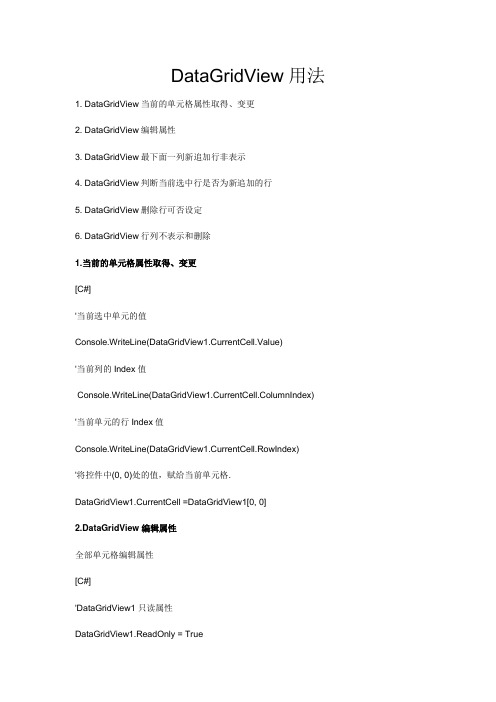
DataGridView用法1. DataGridView当前的单元格属性取得、变更2. DataGridView编辑属性3. DataGridView最下面一列新追加行非表示4. DataGridView判断当前选中行是否为新追加的行5. DataGridView删除行可否设定6. DataGridView行列不表示和删除1.当前的单元格属性取得、变更[C#]'当前选中单元的值Console.WriteLine(DataGridView1.CurrentCell.Value)'当前列的Index值Console.WriteLine(DataGridView1.CurrentCell.ColumnIndex) '当前单元的行Index值Console.WriteLine(DataGridView1.CurrentCell.RowIndex)'将控件中(0, 0)处的值,赋给当前单元格.DataGridView1.CurrentCell =DataGridView1[0, 0]2.DataGridView编辑属性全部单元格编辑属性[C#]'DataGridView1只读属性DataGridView1.ReadOnly = True指定行列单元格编辑属性[C#]DataGridView1.Columns[1]ReadOnly = TrueDataGridView1.Rows[2].ReadOnly = TrueDataGridView1[0, 0].ReadOnly = True根据条件判断单元格的编辑属性下例中column2的值是True的时候,Column1设为可编辑[C#]代码private void DataGridView1_CellBeginEdit(object sender, DataGridViewCellCanc elEventArgs e){if (this.DataGridView1.Columns[e.ColumnIndex].Name.ToString().Eq uals("Column2")){if (DataGridView1["Column2", e.RowIndex].Value.ToString().To Lower().Equals("true")){DataGridView1["Column1", e.RowIndex].ReadOnly = false;}else{DataGridView1["Column1", e.RowIndex].ReadOnly = true; }}}复制代码3.DataGridView最下面一列新追加行非表示[C#]DataGridView1.AllowUserToAddRows = False4.判断当前选中行是否为新追加的行[C#]if (DataGridView1.CurrentRow.IsNewRow){Console.WriteLine("当前行,是新添加的行");}else{Console.WriteLine("当前行,不是新添加的行");}5. DataGridView删除行可否设定[C#]DataGridView1.AllowUserToDeleteRows = False根据条件判断当前行是否要删除[C#]代码1private void DataGridView1_UserDeletingRow(object sender, DataGridViewRow CancelEventArgs e)2 {3456if (MessageBox.Show("确定要删除吗?", "删除确认", MessageBoxButton s.OKCancel, MessageBoxIcon.Question).Equals(System.Windows.Forms.DialogResul t.OK))7 {89 }10else11 {12 e.Cancel = true;13 }14 }复制代码6. DataGridView行列不表示和删除行列不表示[C#]'DataGridView1的第一列不表示DataGridView1.Columns[0].Visible = False'DataGridView1的第一行不表示DataGridView1.Rows[0].Visible = False行列表头部分不表示[C#]DataGridView1.ColumnHeadersVisible = FalseDataGridView1.RowHeadersVisible = False指定行列删除[C#]DataGridView1.Columns.Remove("Column1")DataGridView1.Columns.RemoveAt(0)DataGridView1.Rows.RemoveAt(0)选择的行列删除(多行列)[C#]'DataGridView1删除选中的行foreach (DataGridViewRow r in DataGridView1.SelectedRows) {if (!r.IsNewRow){DataGridView1.Rows.Remove(r);}}。
datagridviewtextboxdropdowncolumn

datagridviewtextboxdropdowncolumn【原创版】目录1.数据网格视图(DataGridView)2.文本框(TextBox)3.下拉列表(DropDown)4.列(Column)正文在计算机编程中,数据网格视图(DataGridView)是一种常用于显示和编辑数据的控件。
它可以让用户轻松地查看和操作数据,类似于电子表格软件,如 Microsoft Excel。
数据网格视图中包含多个列,每个列都可以包含不同类型的数据,如字符串、数字、日期等。
文本框(TextBox)是一种简单的输入控件,用于在程序中输入文本数据。
文本框通常用于获取用户输入的信息,例如用户名、密码等。
在数据网格视图中,文本框可以用作单元格的编辑控件,以便用户在单元格中输入文本数据。
下拉列表(DropDown)是一种常用于显示选项列表的控件。
在数据网格视图中,下拉列表可以用于显示一组可选值,以便用户从中选择一个值。
这可以节省空间,并确保数据保持一致和准确。
下拉列表通常与文本框或组合框(ComboBox)一起使用,以便用户从中选择一个值,而不是在文本框中输入值。
列(Column)是数据网格视图中用于显示和存储数据的基本单元。
每列都可以包含不同类型的数据,并且可以对数据进行排序、筛选和分组操作。
在数据网格视图中,列通常具有独立的标题、数据类型和默认值。
用户可以根据需要添加、删除或修改列以满足不同的数据需求。
总之,数据网格视图、文本框、下拉列表和列是计算机编程中常用的控件和组件,用于显示、编辑和操作数据。
它们在各种应用程序和场景中都有广泛的应用,如数据录入、数据分析和数据可视化等。
- 1、下载文档前请自行甄别文档内容的完整性,平台不提供额外的编辑、内容补充、找答案等附加服务。
- 2、"仅部分预览"的文档,不可在线预览部分如存在完整性等问题,可反馈申请退款(可完整预览的文档不适用该条件!)。
- 3、如文档侵犯您的权益,请联系客服反馈,我们会尽快为您处理(人工客服工作时间:9:00-18:30)。
在C# WinForm下做过项目的朋友都知道,其中的DataGridView控件默认只支持DataGridViewButtonColumn、DataGridViewCheckBoxColumn、DataGridViewComboBoxColumn、DataGridViewImageColumn、DataGridViewLinkColumn和DataGridViewTextBoxColumn六种列类型,如果你想要在DataGridView的列中添加其它的子控件,则需要自己实现DataGridViewColumn和DataGridViewCell,这就意味着你需要从现有的列中继承并改写一些方法,如实现一个支持单选按钮的列,或支持三种选择状态的多选按钮的列。
上面两个截图分别为RadioButton列和支持三种状态的CheckBox列在DataGridView中的实现效果,我是在Windows 2003中实现的,因此显示的效果跟在XP和Vista下有些区别,Vista下CheckBox的第三种状态(不确定状态)显示出来的效果是一个实心的蓝色方块。
下面我看具体来看看如何实现这两种效果。
要实现自定义的DataGridView列,你需要继承并改写两个类,一个是基于DataGridViewColumn的,一个是基于DataGridViewCell的,因为RadionButton和CheckBox的实现原理类似,因此我们可以将这两种列采用同一种方法实现。
创建DataGridViewDisableCheckBoxCell和DataGridViewDisableCheckBoxColumn两个类,分别继承自DataGridViewCheckBoxCell和DataGridViewCheckBoxColumn。
代码如下:public class DataGridViewDisableCheckBoxCell: DataGridViewCheckBoxCell {public bool Enabled { get; set; }// Override the Clone method so that the Enabled property is copied.public override object Clone(){DataGridViewDisableCheckBoxCell cell = (DataGridViewDisableCheckBoxCell)base.Clone();cell.Enabled = this.Enabled;return cell;}// By default, enable the CheckBox cell.public DataGridViewDisableCheckBoxCell(){this.Enabled = true;}// Three state checkbox column cellprotected override void Paint(Graphics graphics, Rectangle clipBounds, Rectangle cellBounds, int rowIndex,DataGridViewElementStates elementState, object value, object formattedValue, string errorText,DataGridViewCellStyle cellStyle, DataGridViewAdvancedBorderStyle advancedBorderStyle, DataGridViewPaintParts paintParts){// The checkBox cell is disabled, so paint the border, background, and disabled checkBox for the cell.if (!this.Enabled){// Draw the cell background, if specified.if ((paintParts &DataGridViewPaintParts.Background) ==DataGridViewPaintParts.Background){SolidBrush cellBackground = new SolidBrush(cellStyle.BackColor);graphics.FillRectangle(cellBackground,cellBounds);cellBackground.Dispose();}// Draw the cell borders, if specified.if ((paintParts & DataGridViewPaintParts.Border) == DataGridViewPaintParts.Border){PaintBorder(graphics, clipBounds, cellBounds, cellStyle, advancedBorderStyle);}// Calculate the area in which to draw the checkBox.CheckBoxState state =CheckBoxState.MixedDisabled;Size size =CheckBoxRenderer.GetGlyphSize(graphics, state);Point center = new Point(cellBounds.X, cellBounds.Y);center.X += (cellBounds.Width - size.Width) / 2;center.Y += (cellBounds.Height - size.Height) / 2;// Draw the disabled checkBox.CheckBoxRenderer.DrawCheckBox(graphics, center, state);}else{// The checkBox cell is enabled, so let the base class, handle the painting.base.Paint(graphics, clipBounds, cellBounds, rowIndex, elementState, value, formattedValue, errorText, cellStyle, advancedBorderStyle, paintParts);}}}public class DataGridViewDisableCheckBoxColumn : DataGridViewCheckBoxColumn{public DataGridViewDisableCheckBoxColumn(){this.CellTemplate = new DataGridViewDisableCheckBoxCell();}}主要是要实现DataGridViewDisableCheckBoxCell的呈现方式,其中设置了CheckBoxState的状态为MixedDisabled,表示支持三种状态,这个是实现效果的核心,如果要实现RadioButton列的效果,只需要将Paint方法改成下面这样即可:protected override void Paint(Graphics graphics, Rectangle clipBounds, Rectangle cellBounds, int rowIndex, DataGridViewElementStates elementState, object value, object formattedValue, string errorText,DataGridViewCellStyle cellStyle, DataGridViewAdvancedBorderStyle advancedBorderStyle, DataGridViewPaintParts paintParts){// Draw the cell background, if specified.if ((paintParts & DataGridViewPaintParts.Background) == DataGridViewPaintParts.Background){SolidBrush cellBackground = newSolidBrush(cellStyle.BackColor);graphics.FillRectangle(cellBackground, cellBounds);cellBackground.Dispose();}// Draw the cell borders, if specified.if ((paintParts & DataGridViewPaintParts.Border) == DataGridViewPaintParts.Border){PaintBorder(graphics, clipBounds, cellBounds, cellStyle, advancedBorderStyle);}// Calculate the area in which to draw the checkBox.RadioButtonState state = value != null && (SelectedStatus)value == SelectedStatus.Selected ? RadioButtonState.CheckedNormal : RadioButtonState.UncheckedNormal;Size size = RadioButtonRenderer.GetGlyphSize(graphics, state);Point center = new Point(cellBounds.X, cellBounds.Y);center.X += (cellBounds.Width - size.Width) / 2;center.Y += (cellBounds.Height - size.Height) / 2;// Draw the disabled checkBox.RadioButtonRenderer.DrawRadioButton(graphics, center, state);}使用RadioButtonState代替CheckBoxState。
